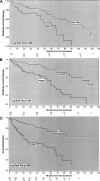Osteomyelitis of the foot and toe in adults is a surgical disease: conservative management worsens lower extremity salvage
- PMID: 15912038
- PMCID: PMC1357594
- DOI: 10.1097/01.sla.0000164172.28918.3f
Osteomyelitis of the foot and toe in adults is a surgical disease: conservative management worsens lower extremity salvage
Abstract
Objective: To characterize the national epidemiology of adult osteomyelitis (OM) and, using a single institutions' experience, test the hypothesis that early surgical therapy as compared with antibiotics alone results in an improved chance of wound healing and limb salvage.
Background: Foot and digit OM is a very common problem for which management is variable and for which few guidelines exist.
Methods: The Nationwide Inpatient Sample (NIS) and a single institution review from 1993 to 2000 form the basis of this study, using ICD-9CM codes for lower extremity foot and digit OM. Demographics, risk factors, and treatments were analyzed against the outcomes of a healed wound, limb salvage, and death.
Results: The NIS included 51,875 patients (incidence = 9/10,000 patients per year) with a mean age of 60 years, and 59% were men. The median length of stay decreased from 9 to 6 days (P < 0.001), but the average admission charge of 19,000 dollars did not significantly decrease over 7 years. Of these patients, 23% underwent a digit amputation and 8.5% suffered proximal limb loss. Single-institution analysis of 237 consecutive patients with OM confirmed a similar mean age (58 years), gender (67% men), and most presented with a foot or digit ulcer (56%). Wound healing was achieved in 56% and overall limb salvage was 80%. Decreased wound healing was associated with peripheral vascular occlusive disease (odds ratio, 0.4; 95% confidence interval, 0.2-0.8, P = 0.006) and preadmission antibiotic use (odds ratio, 0.2; 95% confidence interval, 0.05-1.1, P=0.07), while surgical debridement (odds ratio, 2.2; 95% confidence interval, 1.2-4.2, P = 0.02) was associated with increased healing. Limb salvage was improved with an arterial bypass (odds ratio, 3.9; 95% confidence interval, 1.1-14, P = 0.04), while preadmission solid organ transplant (odds ratio, 0.37; 95% confidence interval, 0.14-0.96, P = 0.04), peripheral vascular occlusive disease (odds ratio, 0.25; 95% confidence interval, 0.12-0.5, P = 0.001), and preadmission antibiotic use (odds ratio, 0.34; 95% confidence interval, 0.15-0.77, P = 0.009) were associated with greater limb loss.
Conclusion: Digit OM is an expensive and morbid disease. Aggressive surgical debridement/digit amputation and selected use of arterial bypass should improve wound healing and limb salvage, respectively. In contrast, antibiotic therapy alone is associated with decreased wound healing and limb salvage.
Figures

Comment in
-
Osteomyelitis of the foot and toe in adults is a surgical disease.Ann Surg. 2006 Mar;243(3):429-30; author reply 430. doi: 10.1097/01.sla.0000202003.66411.d4. Ann Surg. 2006. PMID: 16495714 Free PMC article. No abstract available.
-
Osteomyelitis of the foot and toe.Ann Surg. 2006 Jul;244(1):160; author reply 160-1. doi: 10.1097/01.sla.0000226501.30233.fe. Ann Surg. 2006. PMID: 16794405 Free PMC article. No abstract available.
References
-
- Caputo GM, Cavanagh PR, Ulbrecht JS, et al. Assessment and management of foot disease in patients with diabetes. N Engl J Med. 1994;331:854–860. - PubMed
-
- Akbari CM, Pomposelli FB Jr, Gibbons GW, et al. Lower extremity revascularization in diabetes: late observations. Arch Surg. 2000;135:452–456. - PubMed
-
- Boulton AJ, Kirsner RS, Vileikyte L. Clinical practice: neuropathic diabetic foot ulcers. N Engl J Med. 2004;351:48–55. - PubMed
-
- Ramsey SD, Newton K, Blough D, et al. Incidence, outcomes, and cost of foot ulcers in patients with diabetes. Diabetes Care. 1999;22:382–387. - PubMed
-
- Kellicut DC 3rd, Sidawy AN, Arora S. Diabetic vascular disease and its management. Semin Vasc Surg. 2003;16:12–18. - PubMed
MeSH terms
Substances
LinkOut - more resources
Full Text Sources
Medical

